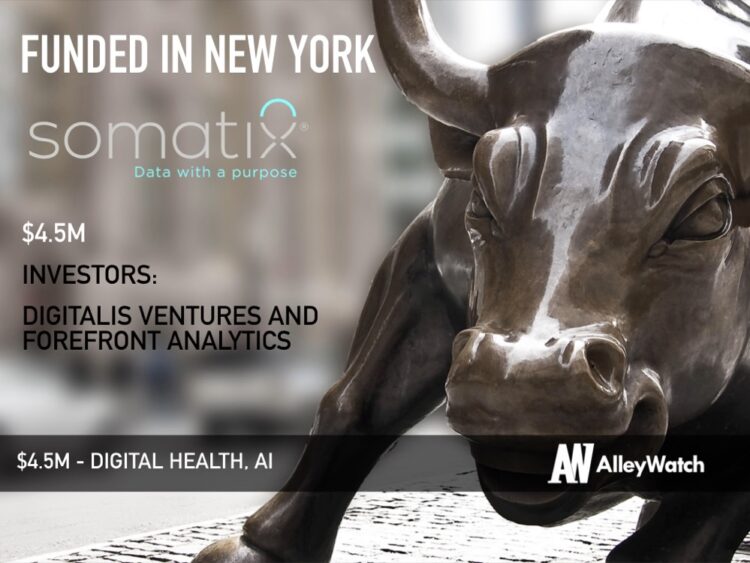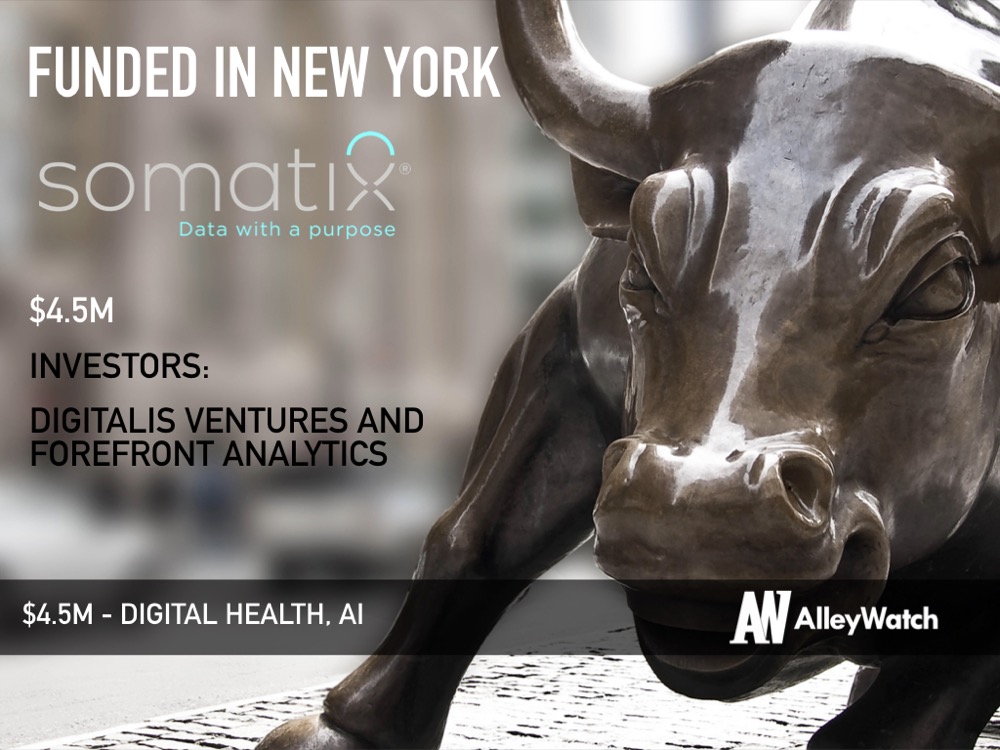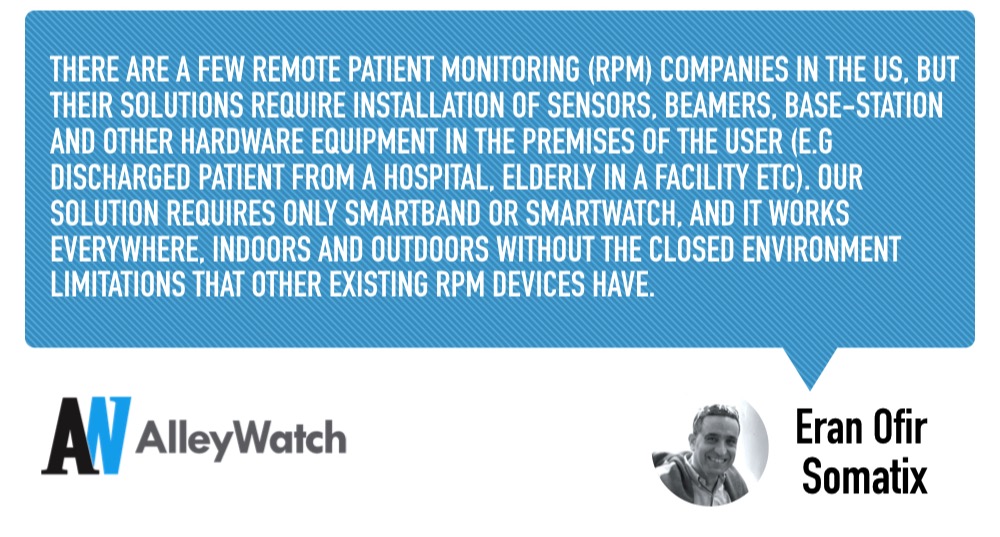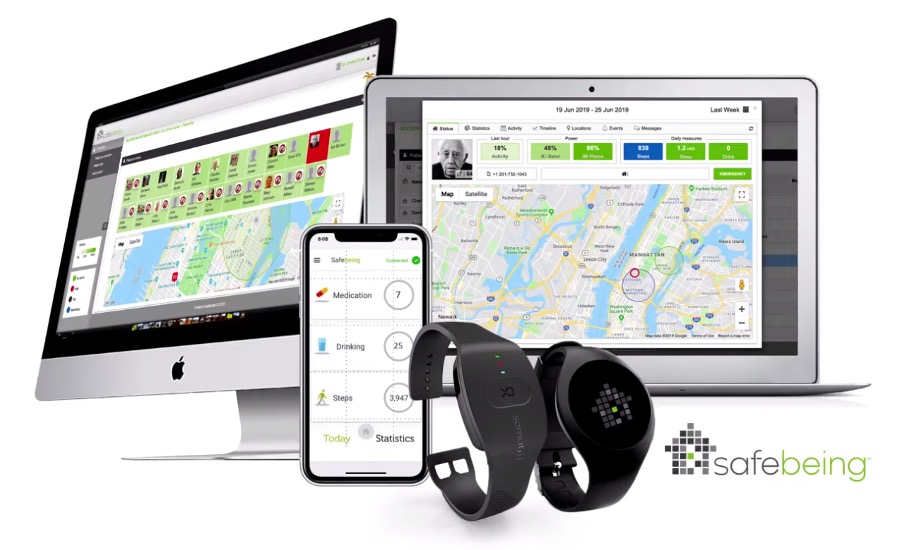1 in 3 senior citizens suffers from a fall each year according to the CDC but software companies like Somatix have built life-saving wearable technology that passively monitors a patient’s wellbeing, allowing healthcare providers to intervene before serious accidents happen. Somatix’s offers its signature SafeBeing™ software solution to elderly care facilities and rehab centers on a Per-User/Per-Month basis. Data collected from the platform is accessible to healthcare providers via a caregiver dashboard that records wandering, medication, sleep activity, hydration, and much more.
AlleyWatch sat down with Somatix CEO and Cofounder Eran Ofir to learn more about how Somatix is playing a leading role at the interaction of digital health and wearables, the company’s future expansion plans, and latest round of funding.
Who were your investors and how much did you raise?
Our funding timeline:
- 2015: $1.5M in seed capital
- 2017: A round of $5.5M
- 2019: $4.5M bridge investment
Our total investment raised to date is now $11.5M. The lead investors are Digitalis Ventures and Forefront Analytics.
 Tell us about the product or service that Somatix offers.
Tell us about the product or service that Somatix offers.
Somatix is a provider of SafeBeing™, a wearable-enabled RPM (Remote Patient Monitoring) software platform to healthcare providers. Our cost-effective solution uses patented gesture detection technology and machine learning algorithms to analyze a user’s gesture data in real-time. The algorithms remotely and passively detect physical and emotional indicators for generating insights on risk factors for adverse events, activity levels, sleep quality, poor medical compliance, falls, dehydration, irregularities and more. This data delivers important clinical insights to healthcare providers, helping them maintain continuous contact with and improve the wellbeing of those under their care. In addition, both patients and loved ones have increased peace of mind about their care and we see improved patient adherence to treatment plans, a critical factor in improving patient outcomes.
What inspired the start of Somatix?
In 2015, Uri Schatzberg, the CTO and the cofounder of the company came up with a unique technology (that was later patented). The proprietary technology tracks the raw data of sensors that exist in wearables and we can tell, in real-time, the gestures of the patient wearing the band. Following two healthcare accelerators we participated in 2016 (Dreamit Health in Philly and New York Digital Health Accelerator in NYC), we realized the ability of the technology in enabling healthcare providers to remotely monitor patients and intervene, based on the context and the well-being of the individual. This is entirely unique on the market today and we believe the technology can not only improve patient outcomes but preserve the dignity and quality of life of the patient. We are passionate about the potential to extend high-quality healthcare beyond the walls of care facilities.
What market does Somatix target and how big is it?
The healthcare providers market that Somatix is targeting is huge. We work with elderly care facilities (independent living, assisted living, sub-acute short-term care, and nursing homes), hospitals and rehab centers. We selected highly focused vertical markets in order to track specific outcome improvements and how both providers and patients adapt and utilize the technology. In addition, we envision our data being used to aid further research through the collection of information that has never been collected before. All these insights can be used to roll the technology out to additional vertical markets as we grow.
What’s your business model?
The business model is Software as a Service. No software or hardware installation is needed at the premises of the enterprise customer, and everything could be done via web interface and mobile apps. The customers are paying based on Per User Per Month licensing. The beauty of the model is that new releases in software can be pushed out without having to purchase or upgrade devices. In addition, this is an affordable and familiar model for providers. Furthermore, CPT codes may also provide a revenue stream for healthcare providers, based on the designated use-cases.
Who do you consider to be your main competitors?
There are a few Remote Patient Monitoring (RPM) companies in the US, but their solutions require installation of sensors, beamers, base-station, and other hardware equipment in the premises of the user (e.g discharged patient from a hospital, elderly in a facility, etc). Our solution requires only a smartband or smartwatch, and it works everywhere, indoors and outdoors without the closed environment limitations that other existing RPM devices have. Also, we are the only company with that unique gesture detection technology. The AI built into this proprietary technology enables significant ‘machine learning’, resulting in individual insights and predictive analytics presented on the caretaker’s dashboard and mobile app. There is no other technology available today which has this integration and value for the healthcare segment.
What was the funding process like?
To date, the company has raised $11.5M. We were lucky to have investors who understand the healthcare cycle and what it takes, in terms of funds and time, for building a scalable solution, obtain the clinical evidence for it and penetrate the healthcare market in the US, which is one of the most conservative and risk-averse markets. When we started a few years back, many were skeptical of the future of wearables, and there were very few companies that managed to present working solutions using AI. As we evolved, Digital Health became mainstream, and then funding became relatively easier. The intersection of AI technology in Remote Patient Monitoring, a passive wearable device where patients do not have to “do” anything but wear it, and the ability to collect valuable behavioral data and improve outcomes makes this an exciting investment prospect in today’s healthcare market.
What are the biggest challenges that you faced while raising capital?
Healthcare is a unique segment for investment and is very different than other domains in the landscape and lifecycle of companies (and I’ve been building businesses before in telecoms, utilities, and retail). Typically, investors expect startup companies to grow commercially from an early stage, whereas in healthcare there is a period that is called “walking in the desert” in which the company has to provide the product in a series of ‘clinical trials’ with healthcare providers in the target market. This is why it is important to identify early in the funding process the healthcare-oriented investors who understand the lifecycle of healthcare startups. Fortunately, there is a growing investment market as the upside is showing to be quite rewarding with other major entrants including such players as Google and Amazon helping to shine a spotlight on innovation, as well as regulatory changes to encourage more emphasis on patient outcomes. As with any complex technology, there is a period of educating the investment market on the impact potential for the entire industry with something entirely new.
Nominations are now open for AlleyWatch’s 2020 NYC Tech Influencers feature.
Know someone amazing who belongs on this list? Nominate them today here. Nominations open until 2/4. Looking to drive targeted response from the NYC Tech community at scale, learn more about partnering with AlleyWatch on this initiative here.
What factors about your business led your investors to write the check?
We were told by the investors that the appealing factors that led them to invest in Somatix, by that order, were the usual decision factors of an experienced and motivated team, the unique and patented technology and the total addressable market for the company’s product. In addition, we acknowledge the excitement around a technology which can impact how healthcare is delivered in an individualized manner while addressing the major challenges in today’s healthcare given the benefits provided.
We were told by the investors that the appealing factors that led them to invest in Somatix, by that order, were the usual decision factors of an experienced and motivated team, the unique and patented technology and the total addressable market for the company’s product.
What are the milestones you plan to achieve in the next six months?
The next six months are expected to be intense and rewarding. In parallel to deploying Somatix technology to new customers within the northeast, we plan on expanding to more states. In addition, we will be raising Series B financing in order to scale and meet the demand.
While working on funding and commercial expansion, we also have technological milestones related to new capabilities, features, insights and predictive analytics we will present to our existing customers.
What advice can you offer companies in New York that do not have a fresh injection of capital in the bank?
Never give up. Keep pitching your solution, believe in it (assuming you have done your homework as for the market viability and the product-market fit). Eventually, you will find the ear and the investor that this offering will be appealing to. While you do it, run lean with as small overhead that you can allow (not an easy task if you are NYC based). The investment is out there.
Where do you see the company going now over the near term?
In addition to achieving our milestones, we are exerting discipline that is paramount to entrepreneurial success by refusing to be distracted by all the opportunities that are presented from verticals outside our initial scope. While it is encouraging that additional opportunities exist, we must focus on our targeted verticals and deliver.
What’s your favorite restaurant in the city?
There are so many. I go to restaurants of all kinds – Asian, Italian, French, Burger’s bars, Indian cuisine and more. There were quite a few restaurants in town I enjoyed in the last year – with family, friends, and colleagues. I’ll mention three I adore – “Naruto Ramen” in the Upper East that I consider to be the best Ramen in town, “Pastis” bistro in the Meatpacking district for its atmosphere and service and “Gramercy Tavern” in Flatiron district for its top cuisine.
Nominations are now open for AlleyWatch’s 2020 NYC Tech Influencers feature.
Know someone amazing who belongs on this list? Nominate them today here. Nominations open until 2/4. Looking to drive targeted response from the NYC Tech community at scale, learn more about partnering with AlleyWatch on this initiative here.






